Do you know how to take a good selfie? Often times your selfie or profile picture becomes your first impression.
But there is nothing worse than trying to look natural in an unnatural photo shoot. I want to give you some great ideas on how to take a good selfie that optimizes and highlights your best self.
It might sound silly, but the pictures you put on your profiles, your website and your social media send cues to others about who you are and what you stand for.
You want your pictures to be:
- True to Reality
- Flattering
- Authentic
- Positive
That is exactly what I’m going to teach you how to do in this post…and, as always, we are going to do it using science!
Research has found that people develop their first impression of you within one second of seeing your photo! Here’s what’s crazy:
Different photos of you send different messages.
Princeton University researcher Dr. Alexander Todorov found that different images of the same person can create drastically different first impressions. The researchers took slightly different pictures of the same person and asked participants to rate them for various characteristics, such as intelligence, trustworthiness and attractiveness. Each pose got different ratings. The question is:
What is your profile picture saying?
1. Know Your Angles
Where should the camera be when taking a picture? In other words, when you are holding your camera to take a selfie or you give your phone to someone else to take a picture how high should you hold the camera? Should it be above you? Below you? Straight on? There is a science to the angles of your shots. Farhod P. Karimov at the University of Brussels found that camera angles greatly affect your impression of the person.
When someone is viewed from above they are seen as weaker and in need of protection. This makes sense from an evolutionary stand point. Adults see children from above–and they typically need to be taken care of. Check out these mugshots above of Lindsay Lohan and Paris Hilton. I am not sure if they were coached to angle their chins down and look up through their lashes, but the angle of this shot makes you perceive them as more innocent and less guilty. Subconsciously, the angle of the mug shot makes you want to be more lenient on them.
The opposite happens when you see someone from below. They tend to look more self-confident, more sociable and more attractive. Why? As children we admired adults. They took care of us and had everything figured out.
- Action Tip: Take control of the messages your picture is sending out to the world by thinking about the angle of your camera.
2. To Front or Not to Front?
Fronting is a body language term that describes where your body is facing. If you are fronting with someone you are aiming your torso, head and toes towards that person. This is a nonverbal sign of respect. When you view someone straight on in a picture, Karimov found you see them as more trustworthy, open-minded and sympathetic. This makes sense because your brain can take in their entire body and get a full mental snapshot.
You will notice that President Obama’s campaign uses pictures like the ones on the left. He is fronting, viewed slightly from below and has a big smile. His competitors put out pictures like on the right. In those shots he is viewed from above (needs help and is weak) and he is not fronting.
3. Smile Right…or not at all
Do you look fake in your picture? Inauthentic? Too posed? This all comes down to the microexpression.
A microexpression is a brief involuntary facial expression that happens when someone feels an intense emotion. There are 7 universal facial expressions that people make across cultures. Here is a grid of the microexpressions that have been discovered…you can also see our full-face tutorial:
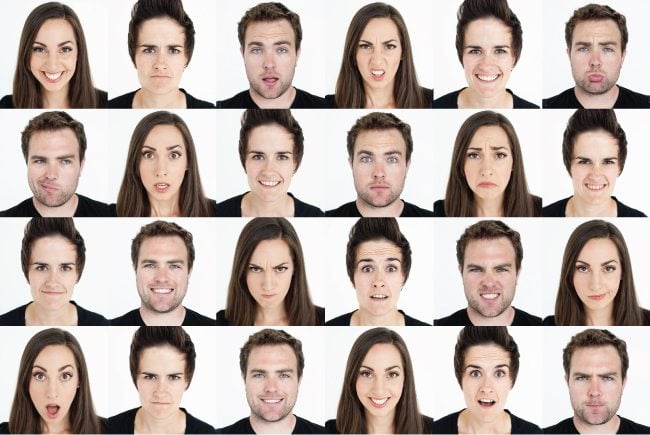
Let’s talk about the universal expression for happiness. The only true indicator of happiness is when the muscles along the sides of the eyes are activated and pulled up (crows feet). However, only 1 in 10 people can consciously activate that muscle. This is why when people are smiling during holiday cards or photo shoots they smile, but it doesn’t look real. It is because the smile isn’t reaching their eyes. Here is the difference:
Fake Happiness vs. Real Happiness:
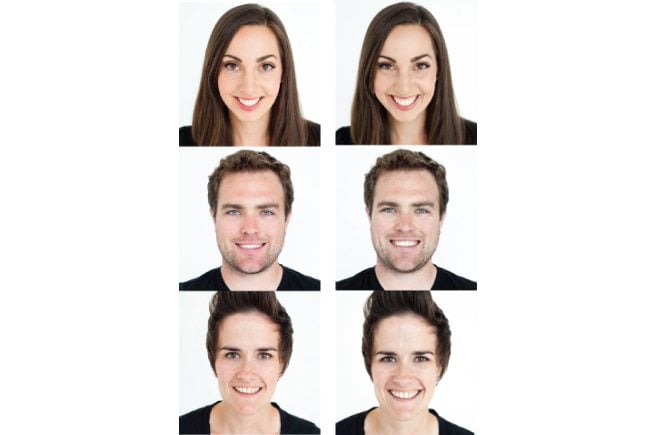
Notice the crow’s feet on the sides of the eyes? It’s when those upper cheeks are engaged. Showing true happiness is essential for making a picture feel genuine, warm and real. Take photos when you are doing something that actually makes you feel good. Think about personal passions or people you care about to bring out that true happiness and make sure your smile reaches your eyes.
I sat down with Diane Cleverly one of our Certified Body Language Trainers and founder of Concierge Conversations. Diane embarked on a fascinating study looking at selfies and smiles.
There are two different types of smiles
The Duchenne smile is the smile that spreads up into the muscles around the eyes. This smile often is associated with positive emotions and can activate a positive emotional feedback loop in the person smiling. We can recognize this smile by noticing the little wrinkles or “crows feet” around the eyes and the cheek “apples.” It’s the kind of smile that makes us want to smile back.
The “Pan Am” smile: named for the flight attendants who flashed this smile to passengers boarding airlines. This smile occurs only in the lower half of the face. This smile is not as often associated with positive emotion.
Diane surveyed 352 selfies taken for the GAC app and found that, while the same small number of both men and women displayed Duchenne or authentic smiles (roughly 1 in 5), significantly more women (p<0.001) favored using a Pan Am smile for the app over a neutral expression, compared to men (34% to 17%). That means that one-third of the women chose to use a smile not associated with positive emotion, but rather with politeness! (Bogodistov and Dost, 2018)
4. Beware Contempt
The other microexpression you have to know about is contempt. Contempt is a one sided mouth raise or smirk. This is a smirk:
It is the universal sign for disdain or hatred. It is the ultimate negative facial expression. Be sure you NEVER have a smirk in your selfies unless you want to tell the world to back away. The smirk grates on us. Celebrities that frequently employ the smirk rub us wrong. When politicians do it, their ratings plummet.
5. Avoid Fear
Fear is the last microexpression I will reference in this post. Fear is when we raise our eyebrows and eyelids as wide as they will go and open our mouth to scream or take in a quick breath. It looks like this:
Sometimes depending on the flash or lighting people can show a small micro expression of fear in their photos! When someone’s eyelids are just slightly wide so you can see a bit of the upper whites of their eyes we think of them as low confident, fearful and anxious–not the signal you want to send out! Notice in these photos:
Go look at your photos right now and make sure you aren’t showing:
- Fake Happiness
- Contempt
- Fear
6. Expand!
If you want to show confidence, power and charisma in your photos you have to know these rules:
- The more physical space someone takes up with their body, the more confident they appear.
- Strong body language is when the forehead and chest are pointed up and shoulders are rolled back.
- Powerful, confident people aren’t afraid to open up their body especially their torso and chest so that they are free of barriers—uncrossed arms and legs.
I did a body language shoot with the amazingly talented Maggie Kirkland of Honeysuckle Photography. In these pictures you can see the more physical space I take up, the more I have my body open with my chest and head up, the more confident I look:

By the way…do you need photo shoot ideas? We have a list you can use for your next photo shoot right here.
7. Professional vs. Casual
Depending on the level of professionalism you want in your shots you can use nonverbal cues differently.
Flirty, Fun, Casual:
- More movement
- Open mouth
- Gazing away from the camera
Professional, Serious, Direct:
- Fronting
- Eye Contact
- Less Movement
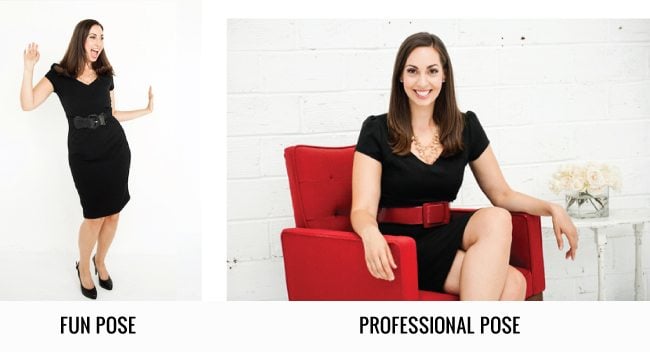
The image on the left is more fun with more movement, more expressiveness and looking off to the side. The image on the right is more professional with a still pose and straight on gazing.
8. Colors
The colors you wear and use in your photos send all kinds of signals. This is called color psychology. Here is a video describing the different colors and what they mean:
9. Video Selfies
Don’t forget that all of these tips can be used in videos. Whether that’s videos on your Instagram or Vine or on your website. Where you position the camera and your body cues matter even more in videos and video selfies!
10. Test Your Photo
If you need a dating profile picture, business headshot or website photo that a lot of important people are going to see, be sure to get feedback on it. Ask people you know and trust like friends and family and try to get feedback from people you are trying to reach.
Or use PhotoFeeler. PhotoFeeler is a free profile photo testing tool that helps people choose better profile photos by cluing them into what their photos really are saying.
We gave this tool a little spin ourselves. Here’s the three photos of me and how they ranked:

With the current votes, the second photo has scored highest in all three areas!
So, what’s your impression saying? How smart, likable, fun and trustworthy are your photos compared to the average? Let’s find out!
How it works:
- Upload your photo
- Vote on other people’s photos (or buy vote credits)
- Wait for the results
This is super helpful if you are trying to decide which photo is best–and in which situation.
How to Take a Selfie with Glasses
Do you wear glasses? Then we have some special selfie tips for you! Try these:
Use the Rule of Thirds
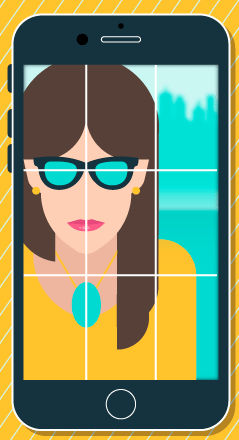
This is an essential and one of the most common photography techniques. Applied to a person or object, it instantly improves the composition and balance of the image. Take your selfie with your eyes situated 1/3 down from the top and off to one side of the frame.
Think about Depth of Field
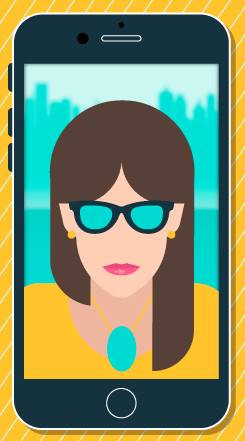
This is the amount of distance between the nearest and farthest objects that appear in sharp focus on a photograph. Basically, it’s the cool feature where the subject is sharp and the background is blurry. Focus on your face, not the environment.
Crop and Edit
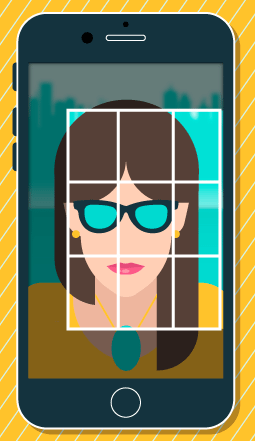
Eliminate distractions in the background, by cropping the photo to accentuate your face, your best feature!
Find the Light
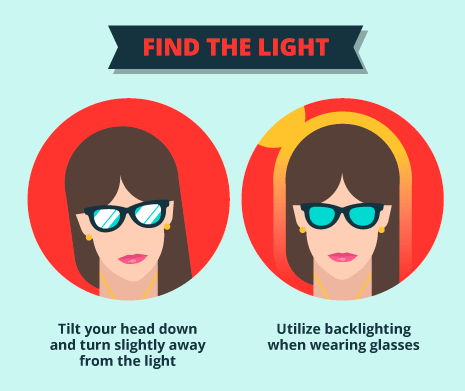
If any of you have watched even one episode of America’s Next Top Model, you won’t be able to forget Tyra Bank’s constant coaching of ‘finding the light.’ A glasses wearer’s worst enemy is glare. Master the glare and maximize the light by tilting your head down and away from the light or by using backlighting.
How to Make Your Profile Picture More Attractive
If you aren’t in a business environment, then you might want to use your profile photo for online dating. We have some specific ideas for you!
We decided to do an experiment to figure out what makes a good profile picture. Using photos from the dating website HotorNot.com, we coded hundreds of pictures, looking for patterns between the highest-rated and lowest-rated photos.
Here’s what we found:
Don’t Hide
Want to show you’re available and open to a relationship? Then be open and show yourself. Photos with hats and glasses were a total buzz kill for the hot factor. Sunglasses were especially detrimental. This is most likely because we use eye gaze to build connection. When we make eye contact with someone (even in a picture), our body produces the hormone oxytocin, which makes us feel connected to someone. When people rating photos can’t see the person’s eyes, they don’t get the hormonal boost necessary for connection.
Funny Note: While hats and glasses weren’t great, headphones didn’t seem to affect ratings at all.
Context Matters
Think your hotness is only about you? Think again! The hottest photos also tended to have some kind of background story—hiking, beach trip, travel, cooking, driving. Photos that included some kind of activity added to the hotness of both men and women.
Trophies: We also counted what we call ‘trophies.’ These are objects that people put on display in their photo in addition to themselves. Men’s favorite objects were guitars, cars, motorcycles and guns. Although none of these impacted hotness scores. Sorry guys, not all women are impressed by a guitar.
Wishful Thinking: A guitar doesn’t help
To Smile or Not to Smile?
The biggest question we get around profile pictures is whether to smile. The answer might surprise you:
For women’s photos, closed mouth smiles were worst. The lowest-ranking women used the closed mouth smile. The highest-ranking women had either a full smile or a neutral face. So, if you’re going to smile, go big.
Surprisingly, for men’s photos, neutral faces tended to do best. High-ranking men had serious or still faces (often looking off into the sunset) and seemed to do better than low-ranking men, who smiled wide.
Get Handsy
Ever wondered if you should show your hands in your picture? If you’re a woman, the answer is YES! Half of the high-ranking women had their hands visible in their photo, while only a third of the low-ranking women did. Hands are our nonverbal trust indicators. It seems that when men are rating women on attractiveness, they also are factoring in trustworthiness, and visible hands are a positive indicator of trust.
The Monroe Gaze
Marilyn Monroe was famous for her flirty head tilt and sultry stare. Our coder noticed that many of the high-ranking women used the Monroe Gaze in their photos. This seems to be a hallmark of ‘hot’ women. A Monroe Gaze is when a woman tilts her head, looks up through her lashes, hoods her eyes, pouts her lips and sometimes exposes her neck. This is a very flirtatious gesture because it looks very similar to what a woman does when she is experiencing physical pleasure. Exposing her neck also releases pheromones.
Remember Lola Bunny?
Notice how, even in action, she shows the Monroe Gaze—tilted head, low eyes, exposed neck:
Or how about Jessica Rabbit? Who almost rests in the Monroe Gaze during her scenes:
Why Don’t We Like Pictures of Ourselves
I recently made my way down to the DMV to get my driver’s license renewed. Since I’ll be carrying this photo ID around with me for the next eight years, I wanted to make sure my hair looked nice, my makeup was done, and that I looked “picture perfect.”
I was feeling pretty good about myself, until the camera flashed and I got a look at my picture. I cringed, “I look like that?”
Whether it’s a group picture, passport photo, or candid shot a friend took of you, we’ve all had similar reactions to our own pictures. But why is that?
Thankfully, science comes to the rescue to explain why our pictures don’t look like we expect.
Your profile picture can make or break your online connections. Research has found people make their first impression of you within one-tenth of a second of seeing your photo!
Choosing the right profile picture matters because different photos of you send different messages. Princeton University Professor Alexander Todorov found that changing your profile picture drastically can change the first impression people have of you. In his study, he took slightly different pictures of the same person and asked participants to rate them for various characteristics, such as intelligence, trustworthiness, and attractiveness. He found even slight variations in the pictures could change people’s perceptions of all of those traits.
The challenge is how do you make sure you choose the right profile picture?
Simple answer: you need to enlist the help of others. Here’s why:
Our Pictures Don’t Look Like Us
An interesting new study found that the pictures we choose to represent ourselves aren’t accurate depictions of what we look like. In fact, strangers are better at choosing pictures that “look like us” than we are.
Dr. David White conducted a study where participants downloaded 10 pictures of themselves from their Facebook page and ranked them from most to worst “likeness.” Then he had a group of strangers try matching up the pictures to a short webcam video of each person.
The strangers ended up picking a different set of “good likeness” pictures for each participant than the participants chose themselves — with seven percent more accurate identification.
Dr. White stated,
“It seems counter-intuitive that strangers who saw the photo of someone’s face for less than a minute were more reliable at judging likeness.”
But this makes sense: Even though we see our own faces everyday, multiple times a day, our existing memory representations of ourselves actually interfere with our ability to choose images that accurately portray our current, true appearance.
Your Face is the Wrong Way Around
Our existing memory representations of ourselves see ourselves in the mirror. So, we tend to choose and like pictures of ourselves where our features are reversed in that way. Enter: selfies. We’re used to seeing ourselves in the mirror. So, when that image is reversed, it doesn’t look quite right.
This is known as the mere-exposure effect–the more familiar we are with something, the more we like it. We are unfamiliar with seeing ourselves head-on, the way friends or strangers view us. So, we don’t like the way we look.
We all know ourselves to look a certain way: our hair is parted on the right, our left eye squints just a bit when we smile, and we have a beauty mark on our left cheek. When we see a picture of ourselves from the opposite perspective, none of our features are where we’re expecting them to be. It makes us feel uncomfortable–the picture is us, but it doesn’t look like us.
You’re Not as Attractive as You Think You Are
Okay, I know this sounds harsh, but let’s go to the science. A joint study between researchers at the University of Chicago and the University of Virginia had participants come to a lab and have their picture taken with a neutral expression. They then made several copies of the pictures and edited them to make the participants look more or less attractive. A few weeks later, the participants came back to the lab and were asked which one of their photos was the original, unedited one. The majority of the participants believed that an enhanced picture was their original, indicating that people see themselves as more attractive than they really are.
Interestingly, this effect was not the same when participants judged strangers’ photos. In that case, the majority of people chose the unedited photo, or a photo that was edited negatively, as the stranger’s original picture.
Seeing yourself as more attractive than you actually are isn’t necessarily a bad thing. It gives you confidence that makes your appearance and presence more attractive in ways that natural good looks can’t do. Research shows that people can pick up on your confidence in your photos and perceive you as more attractive, likable, and competent as a result.
Strangers Have a Different Vision of Attractiveness
Not only do people view themselves as more attractive, they are also unable to judge their own attractiveness. An Australian study had participants submit twelve headshots and decide which ones made them look the most and least of the following traits:
- Attractive
- Trustworthy
- Dominant
- Competent
- Confident
They then had the participants rate each other’s pictures on the same characteristics. After comparing the results, researchers found there was almost no overlap between what individuals thought were their best pictures and what others thought, revealing that what we think of as attractive can vary.
There are two ways you can overcome this cognitive quirk and identify your best profile pictures:
1) Get feedback from other people. Before uploading a new profile picture, pick three or four options and ask other people which one they like most. If you are choosing a profile picture for LinkedIn or an online dating site, tell the individuals that you’re going for a professional/attractive look so they know how to judge you.
Pro tip: This strategy will be much more effective if you choose acquaintances or strangers, not friends, to judge your pictures. Your friends think you are an awesome person and are around you frequently, which causes them to have a favorable bias toward you, similar to the one you have toward yourself. They also likely know what looks make you feel the best — not the most professional, attractive, competent etc.– and may feel inclined to say they like the photo that they know you like the best even if it is not the most ideal one.
Acquaintances and strangers on the other hand, typically don’t have a favorable bias toward you and they don’t know you well enough to be aware of your preferences.
2) The easiest way to get stranger feedback is to use the website Photofeeler. Upload your photos and strangers will rate on different traits depending on if you plan on using them for online dating, professional, or social sites. Photofeeler’s algorithms automatically normalize your scores to give you statistically significant results for all the traits you are seeking feedback on.
Alternatively, you could ask co-workers you’re not close with, mutual friends, and other people you don’t know well for opinions that may not be as uniform but are still better than your own.
Want more out of your selfies? Other articles in this series you might like:

Awesome article and I love the expansion technique. I heard your interview on Gen Y Success about body language for professionals and how expansion improves your mood. Now its one of my go-to’s to stay awake and start the day!
Glad to hear, Ken. Keep it up!
-Danielle & The Science of People Team
It’s crazy that our first impression is made even faster online than in person- I didn’t think that was possible! I’m definitely going to take some time to look through my profile pictures and see what nonverbal cues I’m giving off.
Really good article. So much here I want to study later. Keep it up, this is really helpful.
Glad you enjoyed it, lucrecer! We hope it helps!
-Danielle & The Science of People Team
Would you like to recommend any angle to not to look bulky from face 😛 ?
It’s very hard when you are really taking your selfie because your arm does not extend far enough to get a good picture of your body expansion. You are lucky if you don’t come out with an ackward body position because you are trying to make a good facial expression and find the camera button. And worst of all… the camera is so close everything you don’t like – wrinkles, blemishes, ueven features, etc.- is in close up… ¿how do you manage these things?
You can fix this issue by taking selfie withe a Monopod Selfie Stick Self Portrait. You can find this on amazon. There will be no more problem to take the perfect selfie. Hope this help.
There are phone apps with timers so you can set the timer, put the phone in place and back up and pose.
I’m curious Vanesa… in the email message you sent to promote this article you said “… and avoid the #1 mistake people make in their photos”. What is that #1 mistake people tend to do? Thanks!
Duckface
Hey Josu 🙂 It’s contempt!
-Danielle & The Science of People Team
Love this, thanks for breaking down the science Vanessa!
Hi Vanessa, I am a photographer and would like to say your advice is spot on. Well done.
Thank you, Tony, for your feedback!
-Danielle & The Science of People Team
Vanessa i want to talk with you more more about this topic.becouse i m doing a research about selfies can you send me your mail id
What great advice on taking the perfect selfie! This will come in handy in the photo shoot
Great article on selfies! I also recommend people listen to the song “selfie” by the chainsmokers to get a good laugh in 🙂
Haha, I love that song Andrew! 😉
Wow, that’s really useful! In Austria CV’s usually sport a photo of the applicant and a lot of people pick photos, that aren’t in their favor. I really liked the tips about how to make it more casual or more professional.
Very valuable information 🙂 I will definitely put these tips to use with my new camera!
When trying to pick a profile picture for social media, and Linked In especially, I’ve had a hard time trying to find the best picture to give a great first impression. This will help me – and my friends going through the same “struggle” – make sure we are sending the right message !
Yay! Glad this will help!
Danielle | SOP Team
This is a great way to analyze people’s photos and make sure the messages you send out with yours are genuine and aligned with what you want to communicate- Thanks Science of People!
Great and valuable content presented in an entertaining and accessible way. That’s how it’s done! Thumbs up Vanessa & SoP team! Thanks.
Number 3 is such an important indicator of a genuine smile in photos! Many fail to realize how there are many factors that are taken into consideration when one portrays the emotion of happiness in an image than simply a smile!
Nice article. Absolutely this will help us in our daily lives being and enjoying and even finding new friends.
Danielle McRae, you are an angel.
Thanks
I always try to make my micro expressions by thinking a positive word and it we be reflected into my eyes.
I always try to make my micoexpressions positive by thinking a positive word and that will reflected into my eyes.
RE: How to Take the Perfect Selfie
I have had TMJ since early childhood, so I have always had a “smirk” for a smile, one side turned up while the other side of my smile rests lower on my face. And people have ALWAYS been quick to judge me as disrespectful, something I have carried with me since childhood, with NO IDEA why I get this attitude from folks. (OK, I am a BIT of a smart—) Anyway, lots of therapy later and I have learned to not be defined by what others (wrongly) perceive, but your work is now teaching me how I can potentially shift my appearance and behaviors in a way that might minimize the negative impression that does not reflect who I truly am. (Recently being on a stage for a presentation I remembered your “resting bitch face” tutorial, THANK YOU I was the only one up there who didn’t look like Grumpy Cat when the photographer began snapping!)
Your emails always intrigue me, but today’s was great—How to Take the Perfect Selfie. I then checked my “professional profile pic” and realized I had done nearly everything wrong—and I went to a higher end pro photographer for this thing. Sigh. I will be re-shooting it.
I am not sure what to do about the “smirk” of my unequal smile, other than perhaps make it wider so it genuinely reaches my eyes and makes my face seem friendlier. This was deliberately left less “enthusiastic” because of the nature of my work. So I went for “respectful but approachable” and instead triggered all the “hits” you mention for arrogant and phony!
Your advice to shoot from below is going to be tough, I get more than one chin if my head isn’t raised (I live in In-N-Out Burger territory, I admit it) so I have to figure out how to keep my chin up and shoot from below and not seem “haughty” but that is for the photographer to figure out.
Then add in my choice of wardrobe, from the Color Chart you offered;
In my pic I am wearing a grey suit, with purple silk-satin blouse. As you described, “Grey inspires people to be passive, uninvolved and have a lack of energy.” Coupled with purple blouse, which your color guide describes as “royalty, luxury,” the combo equates (I fear) to someone not working very hard for high-end benefits. This is the opposite of who I am, and I am glad to understand the image I unintentionally communicate with this photo! Oh yes, AND I am turned to the side but then looking at camera, so I get “weak” and “shifty-eyed” mixed into the bargain. I have been putting this pic on my “mixer” networking business cards! What a disaster!
Thanks to you, I will be reshooting this picture, changing out my professional profiles online, and ordering new business cards! THANK YOU, I know Vanessa gets the big kudos and I also know how hard an entire team works to make this come together. I am so glad I came across your info on youtube, and I just bought the book Captivate, AND the “100 ways” tutorial–best 100 bucks I have spent since my wedding dress fabric decades ago, people-watching is so much more interesting now, and being able to know when staff is fudging the facts has been of immeasurable worth. (I don’t use it to nail people, but I do use it to probe with more questions to get to the facts.)
Keep up the good work!
Simply want to say your article is as amazing.
The clarity for your put up is simply cool and i could think you’re an expert on this subject.
Well together with your permission let me to grab your RSS
feed to stay updated with imminent post.
Thanks one million and please keep up the enjoyable
work.